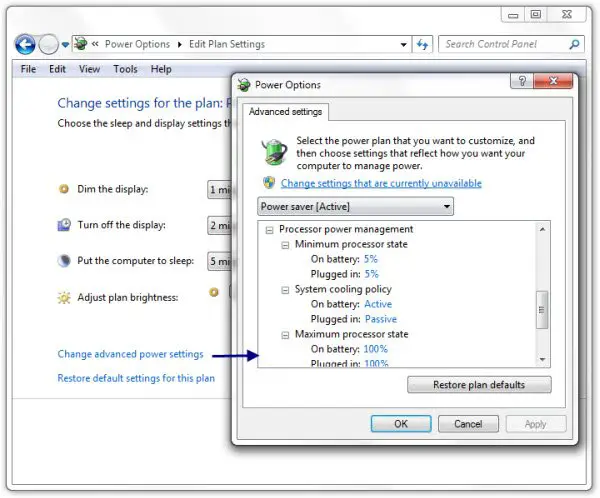Many of you may have noticed that your Windows 11/10 laptop becomes hot when you use it extensively to perform resource-intensive tasks. Gamers, too, may have noticed this. This is because, in such cases, your processor usually runs at its maximum efficiency, viz 100%. Such extensive, intensive usage could cause wear and tear to your processor and possibly reduce its lifespan.
Starting with Windows 7, Microsoft has updated support for ACPI processor power management (PPM) features, including support for processor performance states and idle sleep states on multiprocessor systems.
You can control the state of your processor by controlling its maximum usage to reduce overheating and extend battery life. However, you may have to compromise a bit on performance.
Processor Power Management in Windows 11
While in most cases, leaving the options at Processor Power Management at their default values is the best, for most Windows users, some of you may want to tweak them a bit.

To do so, open Control Panel > Power Options > Advanced Settings.
Under Processor Power Management, you will see three settings: Minimum Processor State, Maximum Processor State, and System Cooling Policy.
The Minimum Processor State and Maximum Processor State settings can lock the system processors into a specific throttle state. The default values vary from 5% (minimum) to 100% (minimum or maximum) depending on the Power Option used.
What is Minimum Processor state?
It specifies the minimum processor performance state. The performance state is specified as a percentage of the maximum processor frequency. Depending on your Power Option in use, you may keep any value between 5% and 100%.
What is Maximum Processor state?
It specifies the maximum processor performance state. The performance state is specified as a percentage of the maximum processor frequency. If your laptop is overheating, you may want to consider setting its maximum value to 90%.
Related: How to hide Minimum and Maximum Processor State.
System Cooling Policy
This policy setting configures how Windows responds to high thermal conditions on systems that support active cooling features, such as fans. You have two options. Active and Passive.
- Active: It increases fan speed before slowing down the processor. The system enables active cooling features such as fans before it reduces the processor performance.
- Passive: It slows the processor before increasing fan speed. The system reduces the processor performance before it enables active cooling features such as fans.
To learn more about Processor Power Management, you can download this technical paper from Microsoft. This paper provides details of the support in Windows, describes how PPM functions with the Windows power policy store and provides guidelines for firmware developers and system designers.
Read next: Check how much Power your Computer needs.